Starting from the pioneering researches
of Oersted, Henry, Faraday, Ampère, in 1864 J. C. Maxwell
developed his “Dynamic Theory of the Electro-Magnetic
Field”, demonstrating mathematically the existence of
the electro-magnetic waves. (Fig. 1)
 |
Fig. 1 - Set of differential equations
developed by Maxawell baseed on t he experimental work
of Ampère, Henry, Faraday and others, which led
him to predict tlhe properties of electro-magnetic waves
long before t heir existence was suspected..
(Technology Review) |
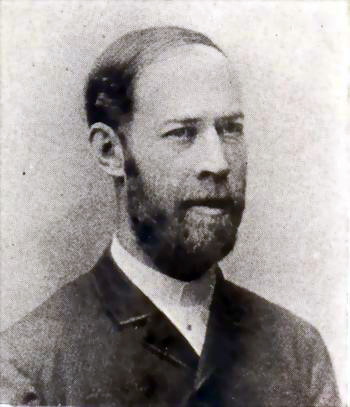 |
Further
on the formulation of Maxwell theory, Henrich Hertz working
in the universities of Kiel and Bonn, in Germany, proved
experimentally the existence of the electro-magnetic waves.
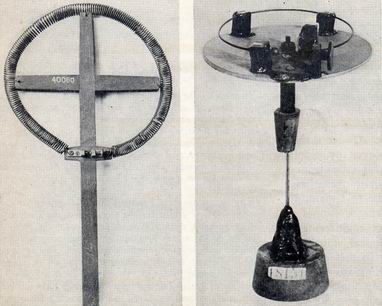 |
| Ressonators, originally used by
Hertz to demonstrate the existence of electromagnetics
waves. (Electronics) |
|
Heinrich Hertz |
Hertz's historic researches
in electro magnetism led to new horizons in the wireless communications
by gathering together many inventors and innovators.
Among them are:
Oliver Lodge
A physicist at the University of Liverpool, designed
in 1894 an effective system of wireless reception of the electro
magnetic waves whose main innovation consisted to use the
coherer, originally invented by E. Branly, instead of the
Hertz’s loop. (Fig. 3)
Fig. 3
Electro-magnetic waves wireless transmission and reception
system in the beginning of XX century. The spark gap
in the induction coil can be switched on and off by
a telegraphic key. Oscillatory currents from the spark
gap excite the coherer, which becomes conductive. When
the coherer is placed in series with a battery and a
telephone receiver, it switch the currents on and off
in synchronization with the telegraphic key in the transmitter.
a) Telegraphic key
b) Spark gap
c) Coherer
d) Telegraphic receiver
e) Telephone receiver
|
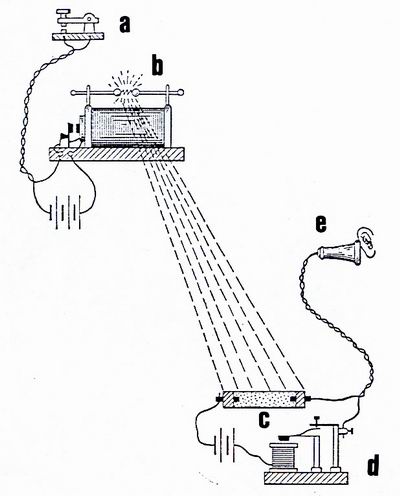 |
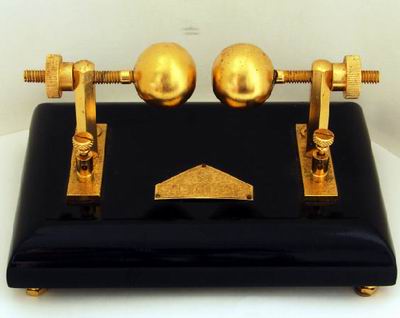 |
|
|
| Fig 4 - Replica of a spark
gap used in early transmitter system. |
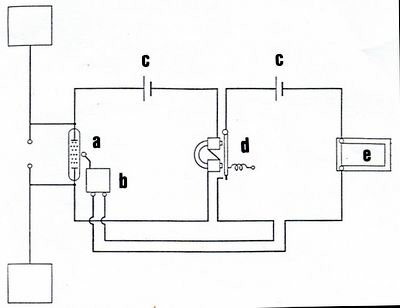 |
Fig 5
Diagram of the receiving station developed by Oliver
Lodge in 1894 where:
a) Coherer
b) Trembler
c) Battery
d) Relay
e) Inker
|
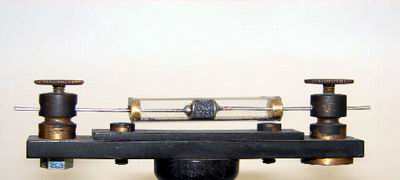 |
| Fig. 6 -Replica of the cohesor originally
invented by E.Branly. |
Guglielmo Marconi
Educated in Italy primarily by tutors, Marconi
early developed an absorbing interest in Physics and
Chemistry. In the beginning of his career he improved
on the Hertzian oscillator by constructing transmitting
apparatus, which, from an elevated antenna, discharged
across a spark gap to earth. He also improved on Lodge’s
coherer by evacuating the tube with more selected metal
fillings as well grading the connection plugs.
In 1896 he moved to England when he started his commercial
and technical activities on the behalf of wireless transmission
and reception of electro magnetic waves. On December
12, 1901, Marconi was working in his receiving station
located in Newfoundland and was able to hear the historical
feeble signal of the Morse telegraphic letter “S”
transmitted from England.
|
Ernst F. W. Alexanderson
A native from Sweden had graduated as an electrical and mechanical
engineer from the Royal Technical University in Stockholm.
Later on he studied under Professor Sabli in Berlin and decided
to come to America to work under supervision of Steimetz at
GE. In 1904 he was assigned by the company to supervise the
manufacturing of a large alternator, capable to generate frequencies
up to 100,000 cycles, originally ordered by Reginald Fessenden,
when he introduced several technical modifications. During
this development stage of the high frequency alternator, one
of Alexanderson main targets was the investigation the problem
of modulating the powerful currents of the apparatus by minute
energies of the voice. Alexanderson was responsible also for
others important developments such as: the magnetic amplifier
as well as the multiple-tuned antenna, which materially increased
the efficiency of the radiation.
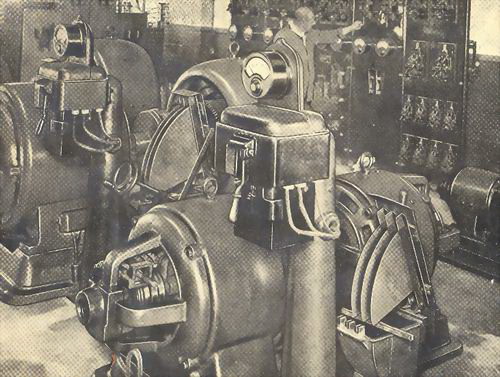 |
Illustration of a radio
station transmitter using the Alexanderson alternator
circa 1916. Alexanderson working at General Electric
laboratories introduced several innovations in order
to improve even more the machine's performance. One
of the most important innovation consisted to replace
the apparatus' wooden armature by an iron made one.
|
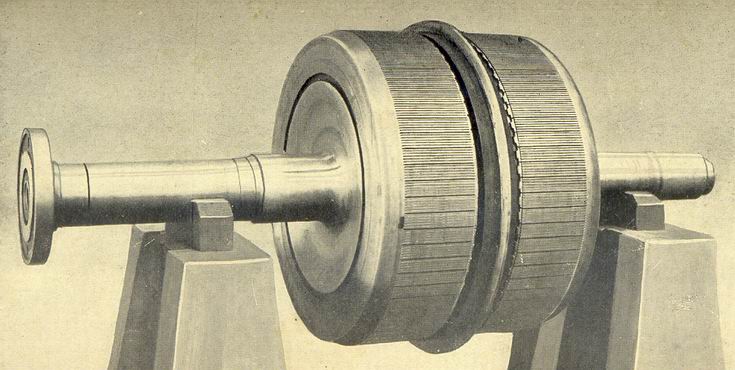 |
Close
up view of the rotor used in an alternator for generating
electromagnetic waves circa 1915. |
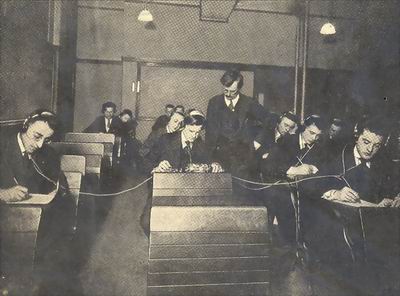 |
| Morse code training course circa later
1910’s. |
Reginald Fessenden
of the University of Pittsburgh in 1900 did one of the
first practical demonstrations on the speech transmission
by means of the electro-magnetic waves using two masts
15 m high and 1600 m apart. Starting from the early
researches made by Nikola Tesla, Fessenden believed
he could design an equipment to transmit and receive
Morse code signals across the Atlantic.
His first high-frequency alternator for producing 10000
cycles was built to his specification by Steimetz of
the General Electric Company in 1903. After several
attempts, he developed in the same year a new receiving
device known as the electrolytic detector much more
sensible to radio frequencies when compared with the
Branly’s coherer.
Therefore, it was to take still several years for his
theory to transmit signals by means of continuous waves
to become possible as it was related mainly due to the
innovations introduced by Alexanderson in the alternator,
which certainly demonstrated it was far superior to
the primitive spark gap transmitting method. |
|
| Interior view of a Fessenden wireless
telephone station. |
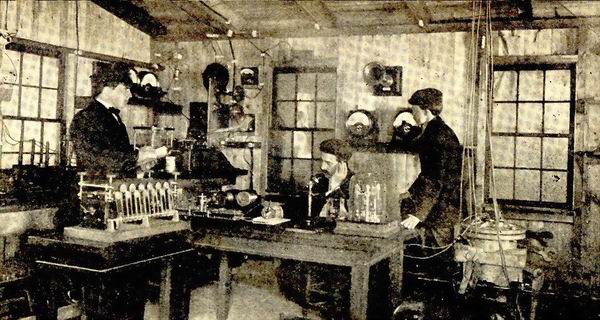 |
| A Fessenden wireless telephone station
at work. |
H.J. Round
In order to improve the selectivity of the feeble radio
frequency signals, in 1911 he invented a balanced crystal
circuit for reception. He employed two crystals working
in opposition, and so set that one was sensitive to
the signal whereas the other only operated when a disturbance
exceeded the value to which it had been adjusted. |
A.S.Popoff
As a professor of the University of Kronstadt, in Russia,
in 1895 improved further on the Lodge’s electro
magnetic reception system. In his system the coherer
was protected from the local effects of local sparks
at the relay contact by inserting chocking coils in
the wires along which the waves from such sparks could
run. In lieu Hertz’s loop of wire he used a long
vertical wire, insulated at its upper end and connected
to earth through the coherer at its lower end. |
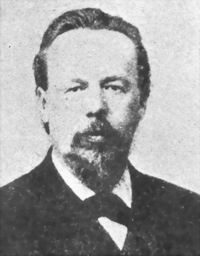 |
| Alexander S. Popoff |
|
|